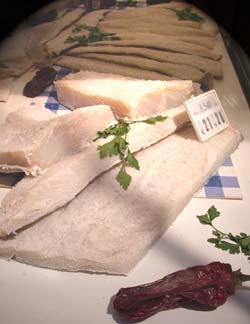
Salt fish bacalao on display in a Barcelona window…
Spanish food cannot be described in just a few words, it is as complex as Asian food, varied as all European fare put together, and reflects the diversity of Spain itself. As the popular saying goes: in the south of Spain they fry, in the central areas they roast, and in the north they make stew. But even this statement may prove to be too broad in it’s conclusions.
Traditionally, food in Spain was a mostly a reflection of the materials they had in the various areas. Remember that once upon a time refrigeration and easy shipments of fresh food hundreds and even thousands of miles from its source was impossible, thus you made do with what you had locally. In the past Spain enjoyed healthy peasant fare for the most part, stretching a hambone or a few scraps of chicken into a meal for the entire family out of basic necessity. It has only been since prosperity returned to the Spanish during the 1960s that they have been able to enjoy products and foods imported from around the world.


